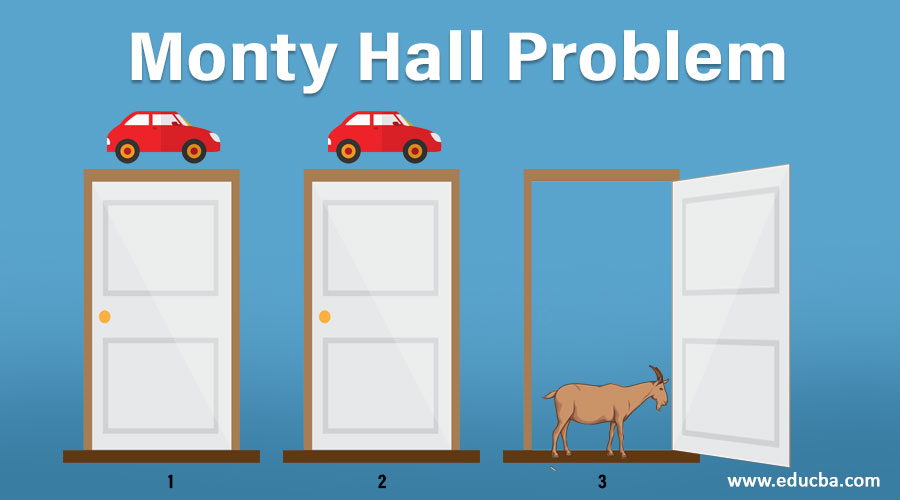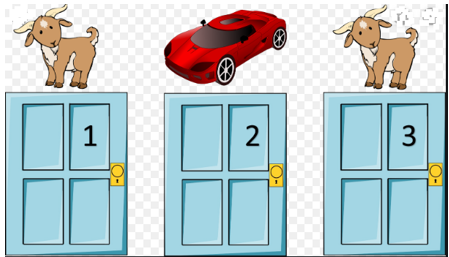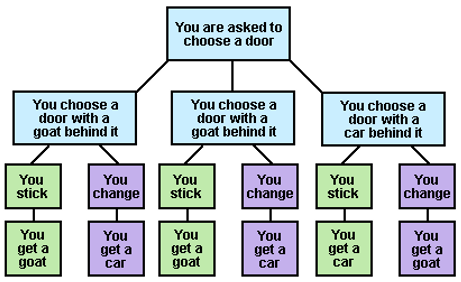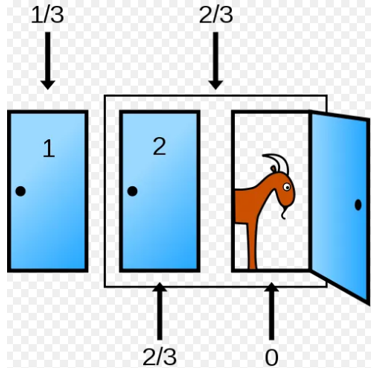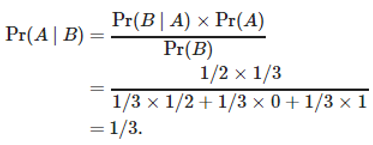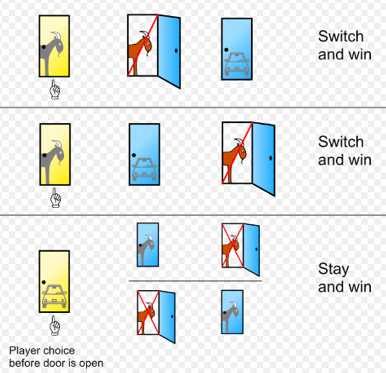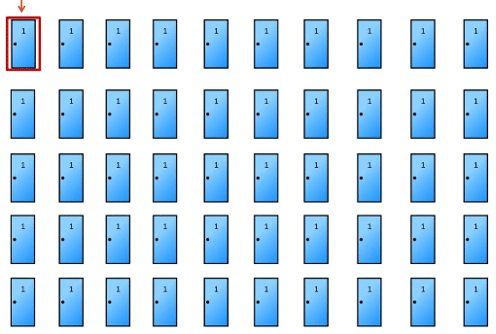Updated June 2, 2023
Introduction to Monty Hall Problem
Monty Hall Problem is one of the most perplexing mathematics puzzle problems based on probability. It was introduced by Marilyn Savant in 1990. It is named after the host of a famous television game show ‘Let’s Make A Deal’. In this game, the guest has to choose among three closed doors, only one of which has the surprise car behind it, and two of them have goats behind them shown in the image below. The contestant has to pick one door. After they make their first choice Monty Hall (Host) opens one door (which the contestant has not chosen), which always has a goat behind it. Monty Hall (Host) then asks the contestant whether they want to switch the choice, i.e. the door which the contestant neither chosen nor the host opened.
Source Link: https://www.norwegiancreations.com/2018/10/bayes-rule-and-the-monty-hall-problem/
An explanation for the Monty Hall Problem
The main goal of the puzzle is to maximize the chances to win the game. This problem can be solved with the help of probabilistic analysis:
Source Link: https://brilliant.org/wiki/monty-hall-problem/
In the beginning, the guest has a 1 in 3 chance of picking the correct door. As the guest picks one among the three doors, and then the host opens one door among the remaining two doors, it is revealed to be a goat; the guest then has more information than the initial 1 in 3 choice, which was random. After this, the host then offers the guest a choice between sticking with the previous choice 1/3rd chance or going with a 2/3rd chance.
Source Link: https://www.theifod.com/the-monty-hall-problem-explained/
The correct choice is that the guest should switch. If the guest does not switch, he/she have the 1/3rd chance of winning the car since the host always shows you a door with a goat, whether the guest initially picked the correct door. As the host has eliminated one of the doors for the guest, the chance of winning can be improved to be better than 1/3rd by switching doors since there is a 2/3rd chance to win the car.
Solution for the Monty Hall Problem
Below is the solution for the Monty Hall Problem:
- Suppose that the guest starts from door number 1 at first as selection and the host always shows any door other than the door number 1, which does not contain the car.
- If the car is behind door number 1, then after the guest picks the door number 1, the host then opens another door, either door number 2 or door number 3 and then the guest switches to the remaining door, either door number 3 or door number 2, thus the guest loses.
- If the car is behind door number 2, then after the guest picks door number 1, then the host is forced to open door number 3 and then the switch to door number 2, thus wins the car.
- If the car is behind door number 3, then as the guest picks the door number 1, the host is forced to open door number 2, and then the guest will then switch to door number 3; hence the guest wins the car in this case.
- Thus in 2 of the 3 possibilities, there are more chances to win, and the probability of winning is 2/3 due to switching. This is the case of conditional probability, which can be calculated using Baye’s Theorem. Baye’s Theorem states the probability calculation as given below:
- The chance that the car is behind door 1 is 1/3. As there are two doors that are left now. The other two doors left will have 1/2 chance of being chosen each. From this, we can calculate the probability as Pr(B|A), which is the probability of event B when A is given. Pr(B) present at the denominator can be calculated as follows:
- When the guest chooses gate number 1, and the host shows a goat behind door number 2, then there is the situation: In the second case, if the car is behind door number 2, then the host opens door number 3 since the host never wants to reveal the car. Since the host opened door number 2 so we can confirm that the car will be either behind door 1, which is the first choice of the guest or door number 3. The probability of the car being behind door 1 is 1/3. This implies that the probability of the car being behind door number 3 is [1 – (1/3)] = 2/3. Hence the guest has to switch to winning the car.
Source Link: https://en.wikipedia.org/wiki/Monty_Hall_problem
Generalizing Monty Hall Problem
This problem can be generalized by taking 100 doors instead of 3 doors. So, let’s say there are 100 doors to pick from in the beginning. The guest picks one door. The host opens 1 of the doors among all other 99, which is having a goat behind it. Then, he offers the choice of whether the guest wants to stick with his/her original door choice whose probability of winning is 1/100 or want to switch to another door which was filtered from 99. Now, the question which arises here is that whether the guest wants a random door out of 100, which was initially guessed, or he/she wants the best door out of 99 i.e. He/ She wants to stick to 1 random chance or wants to select from the best of 99 random chances.
Source Link: https://brilliant.org/discussions/thread/the-best-explanation-to-monty-hall/
Conclusion
When the game is played 50 times using a strategy where we just pick one door once and sticks to it, i.e. and let the host opening the doors and revealing the item behind the doors. By observing at the win rate percent, we will find that the win rate settles around 1/3. Then play 20 times with a strategy of pick and switch technique, i.e. The guest picks a door, and then the host reveals a goat behind other doors and then the guest switches to the other gate. Now by observing the win rate, it can be found that the win rate is 50% to 60%. However, the best strategy of the N-stage Monty Hall problem is that stick to the first choice until the last choice and then switch.
Recommended Articles
This is a guide to the Monty Hall Problem. Here we discuss the explanation, solution, and generalization in a detailed formin detail for better understanding. You can also go through our other related articles to learn more –

